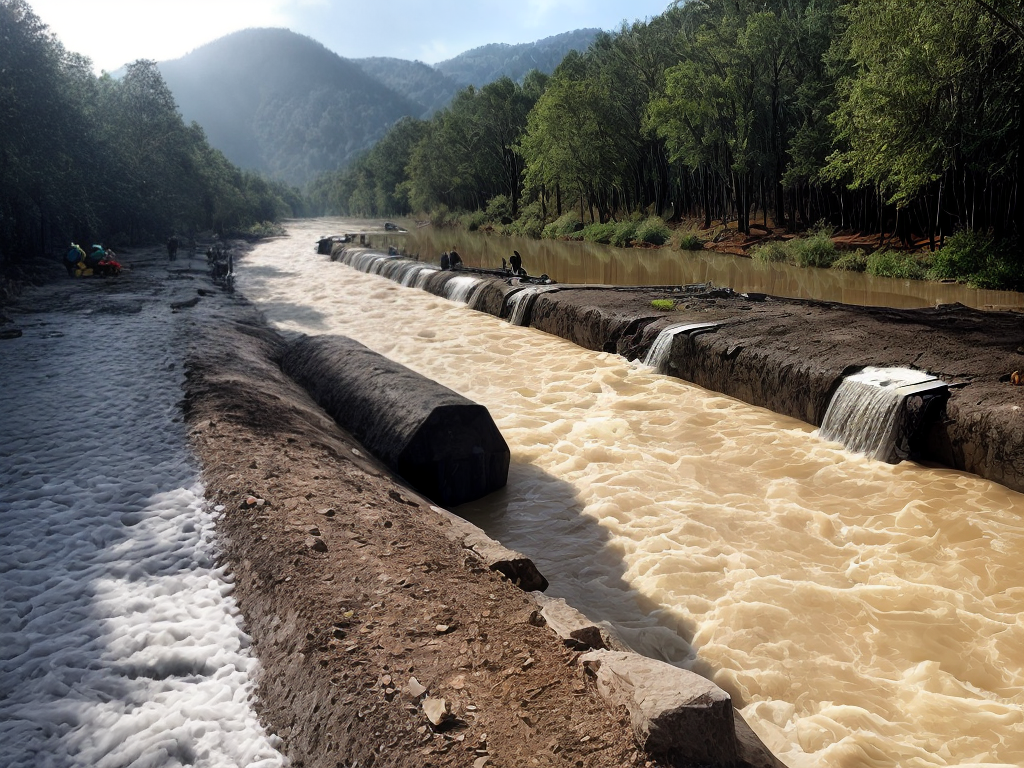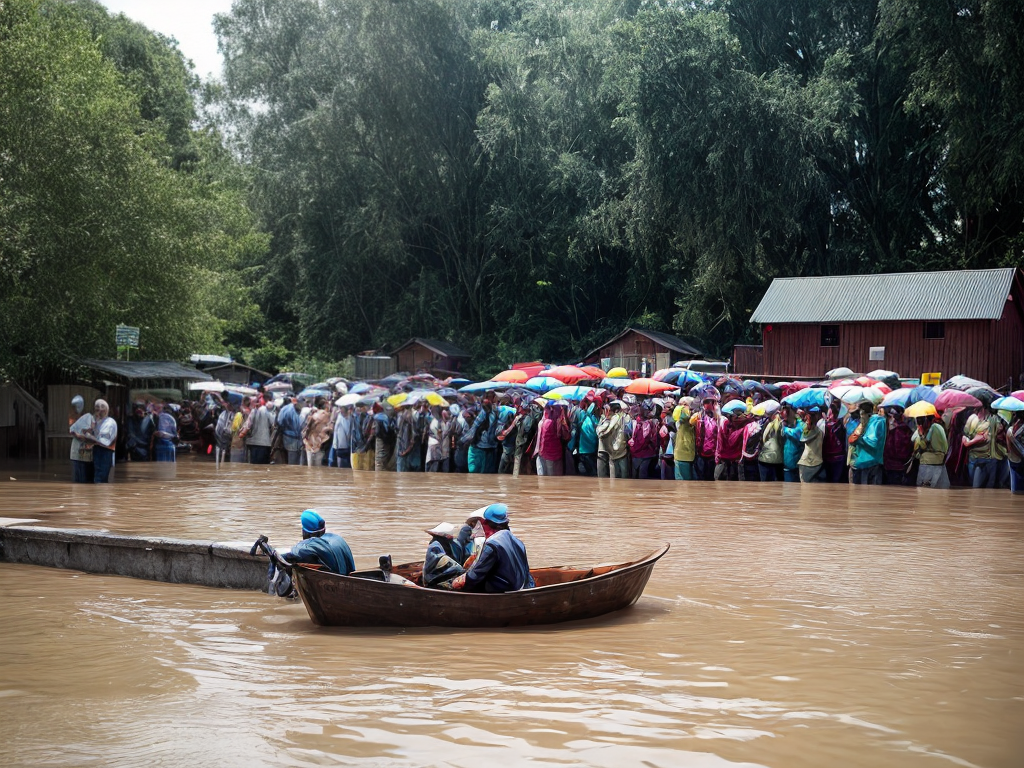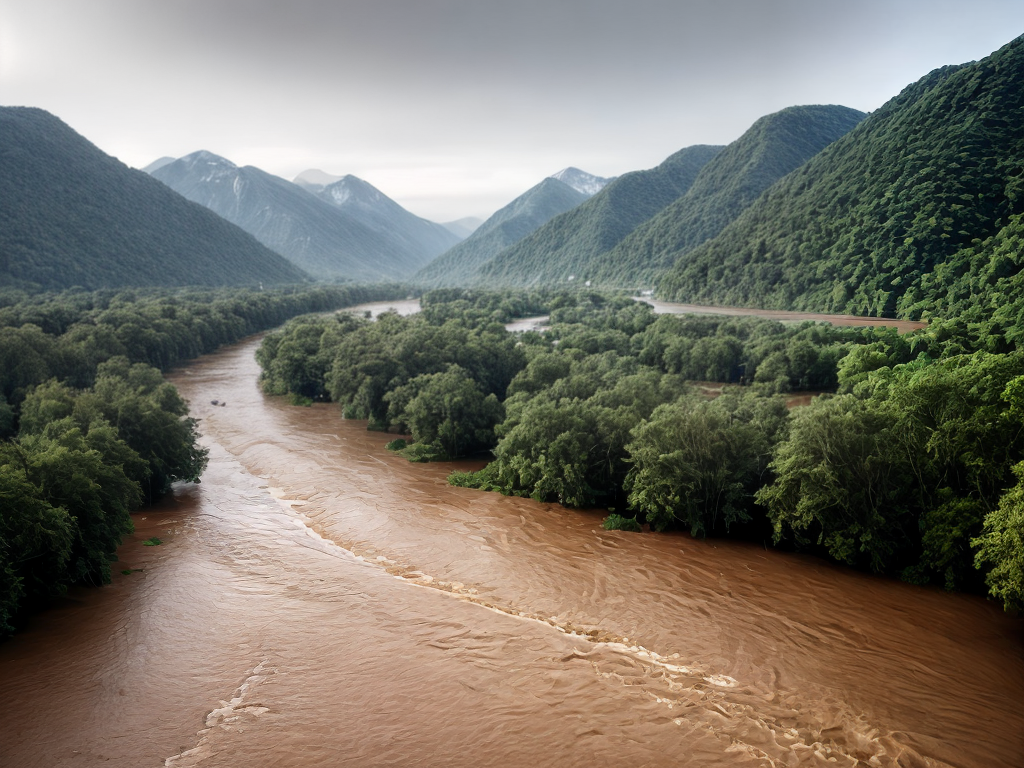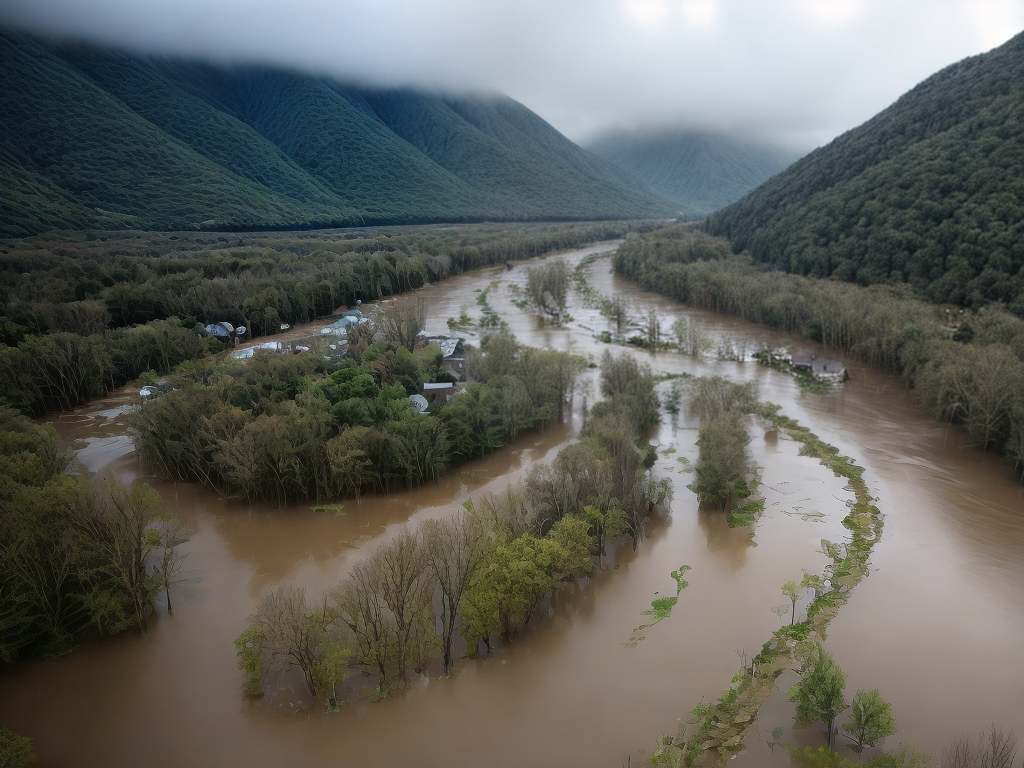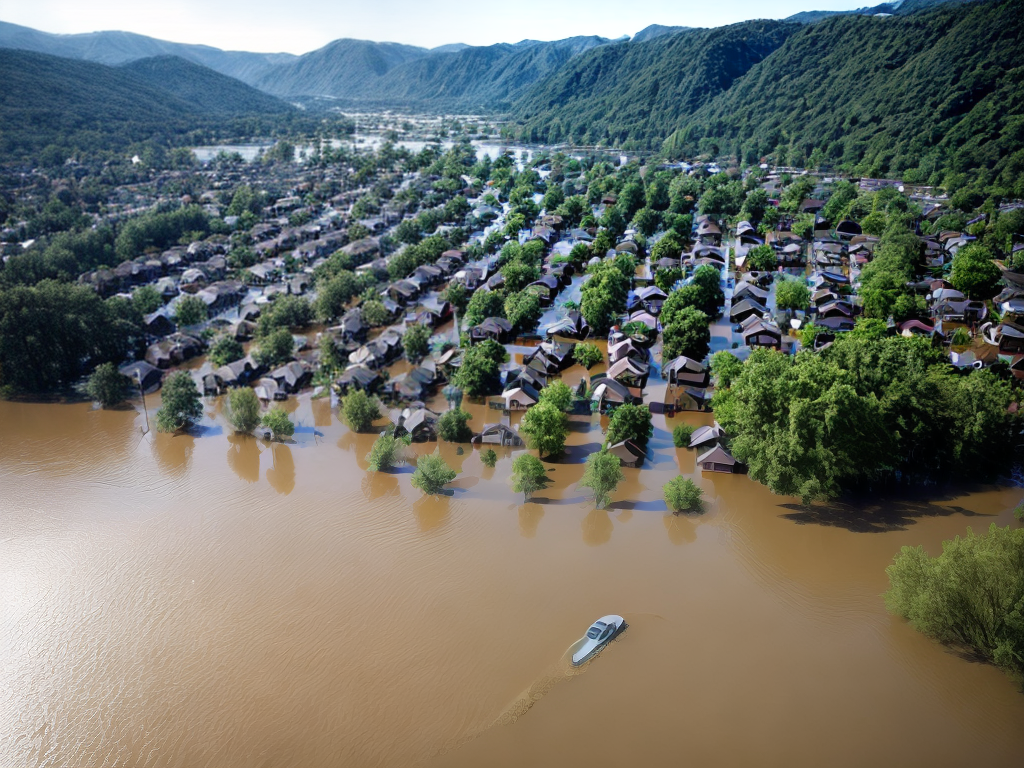As we delve into the realm of flood control projects, we are often presented with a multitude of challenges. However, amidst the daunting nature of such endeavors, there are inspiring success stories that deserve recognition. In this discussion, we aim to highlight recent flood control projects that have not only withstood the test of time but have also proven their efficacy in mitigating the devastating impacts of floods. From the grandeur of the Thames Barrier Project to the innovative solutions found in the Mangrove Restoration Project in Thailand, we will explore the triumphs of these initiatives and their invaluable contributions to safeguarding communities against the wrath of nature.
Key Takeaways
- Successful flood control projects can minimize the risk of flooding and protect critical infrastructure, enhancing community resilience.
- Some flood control projects also have environmental benefits, such as improving water quality, restoring biodiversity, and creating green spaces for the community.
- Economic impacts of flood control projects include increased footfall, job creation, business expansion, and revitalization of local businesses.
- Innovative flood control projects utilize advanced technology, collaborative efforts, and comprehensive measures to effectively manage floodwaters and provide robust defense against floods.
The Thames Barrier Project
The Thames Barrier Project has been a highly successful flood control initiative in London. Constructed in the 1970s, the Thames Barrier is an innovative engineering marvel that protects the city from the threat of flooding. The construction of the barrier involved the assembly of ten steel gates, each weighing more than 3,000 tons. These gates can be raised during high tide to create a barrier across the Thames, preventing tidal surges from entering the city.
The effectiveness of the Thames Barrier in controlling floods is remarkable. Since its completion, the barrier has been closed over 175 times, preventing flooding in central London and safeguarding the lives and properties of millions of people. The barrier has successfully minimized the risk of flooding to a frequency of once every six years, compared to once every three years before its construction.
What sets the Thames Barrier apart is its adaptability and innovative design. The barrier was constructed to withstand rising sea levels and changing tidal patterns, ensuring its long-term effectiveness. The barrier’s computerized control system constantly monitors weather conditions and water levels, allowing for precise and timely response to potential flood threats.
The success of the Thames Barrier Project has inspired other cities around the world to implement similar flood control initiatives. Its innovative construction and effectiveness in protecting London from floods make it a shining example of how engineering and innovation can mitigate the risks posed by natural disasters. The Thames Barrier Project stands as a testament to human ingenuity and our ability to find innovative solutions to the challenges we face.
The Maeslantkering Storm Surge Barrier
Let’s talk about the Maeslantkering Storm Surge Barrier and its construction process, effectiveness, and impact. This barrier was built to protect the Netherlands from storm surges, and it is an impressive feat of engineering. We will explore how it was constructed, how effective it has been in preventing floods, and the impact it has had on the surrounding areas.
Barrier Construction Process
Constructed in the Netherlands, the Maeslantkering Storm Surge Barrier stands as a testament to successful flood control projects. The barrier design of the Maeslantkering incorporates innovative flood control techniques to effectively protect the surrounding areas from the threat of storm surges. The construction process involved meticulous planning and engineering expertise. The barrier consists of two large doors, each weighing around 6,800 tons, which can be closed during high tides and storms to prevent flooding. These doors are supported by steel arms that allow them to swing closed, forming a watertight seal. Advanced technology, such as sensors and computer systems, are used to monitor weather conditions and control the operation of the barrier. The Maeslantkering Storm Surge Barrier showcases the successful application of modern flood control techniques in safeguarding coastal communities.
Effectiveness and Impact
With its innovative design and advanced technology, the Maeslantkering Storm Surge Barrier has proven to be a highly effective and impactful solution for safeguarding coastal communities against storm surges. The barrier’s construction and operation have had a significant impact on infrastructure and community resilience. By effectively blocking incoming storm surges, the Maeslantkering protects critical infrastructure such as roads, bridges, and buildings from the destructive forces of flooding. This ensures that communities can continue to function, preventing disruptions to transportation, utilities, and essential services. Furthermore, the barrier’s presence instills a sense of confidence and security within the local population, enhancing community resilience in the face of future storms. The Maeslantkering’s effectiveness and positive impact on both infrastructure and community resilience make it a prime example of innovative flood control measures.
The Three Gorges Dam
The benefits of the Three Gorges Dam for flood control are undeniable. This innovative project has had a significant impact on mitigating the effects of flooding in the Yangtze River basin. The dam’s construction has brought about both positive impacts and controversies. On one hand, it has effectively reduced the risk of flood disasters, protecting millions of people living downstream. On the other hand, there have been concerns raised about the environmental and social consequences of the dam.
Despite the controversies, the long-term maintenance of the Three Gorges Dam is crucial to its continued effectiveness. Regular inspections and repairs ensure that the dam remains structurally sound and capable of handling future flood events. Additionally, ongoing monitoring of the dam’s environmental impact allows for timely adjustments to mitigate any negative effects.
The Three Gorges Dam represents a remarkable feat of engineering and innovation. Its massive size and capacity demonstrate the commitment of the Chinese government to finding innovative solutions to flood control. The dam’s ability to store and release water strategically has proven invaluable in managing floodwaters and reducing the risk of catastrophic flooding.
The Cheonggyecheon Stream Restoration Project
Let’s talk about the Cheonggyecheon Stream Restoration Project and its key points. First, the project overview: the Cheonggyecheon Stream in Seoul, South Korea was transformed from a concrete channel into a revitalized urban oasis. Next, the environmental benefits: the restoration project improved water quality, restored biodiversity, and created green spaces for the community. Lastly, the economic impact: the project boosted tourism, increased property values, and revitalized the surrounding area.
Project Overview
We embarked on the Cheonggyecheon Stream Restoration Project, transforming a polluted and neglected waterway into a vibrant and thriving urban oasis. This ambitious undertaking was not without its challenges. However, through our dedication and innovative approach, we overcame these obstacles and achieved remarkable results. Here are some of the project challenges we faced and the best practices we employed:
- Environmental Impact: We had to mitigate the potential harm to the ecosystem during construction by implementing sustainable practices and reducing pollution levels.
- Community Engagement: Engaging the local community was crucial to the success of the project. We organized public consultations and incorporated their feedback, fostering a sense of ownership and pride in the restored stream.
- Infrastructure Innovation: Implementing cutting-edge engineering techniques and incorporating smart technologies allowed us to optimize water flow and ensure the long-term sustainability of the restored stream.
Through our perseverance and commitment to innovation, we transformed the Cheonggyecheon Stream into a symbol of urban revitalization and a source of inspiration for future projects.
Environmental Benefits
After successfully overcoming the challenges outlined in the previous section, the Cheonggyecheon Stream Restoration Project yielded significant environmental benefits. The restoration of the stream not only improved flood control measures but also had positive impacts on the surrounding ecosystem. The project resulted in enhanced water quality and increased biodiversity, creating a healthier environment for both flora and fauna. The restored stream also served as a catalyst for economic benefits, attracting tourists and boosting local businesses. Additionally, the project enhanced community resilience by creating a more sustainable and livable urban environment. The Cheonggyecheon Stream Restoration Project stands as a remarkable example of how innovative flood control measures can not only protect communities from disasters but also contribute to the economic and environmental well-being of the area.
Economic Impact
The Cheonggyecheon Stream Restoration Project had a significant economic impact, revitalizing local businesses and attracting tourists to the area. This project not only contributed to the economic growth of the region but also created numerous job opportunities. Here are three reasons why the economic impact of this project is worth celebrating:
- Increased footfall: The restoration of the Cheonggyecheon Stream created an inviting and vibrant atmosphere that drew tourists and locals alike. This influx of visitors resulted in a boost in customer traffic for businesses located in the vicinity, leading to increased sales and revenue.
- Job creation: The project required a skilled workforce to carry out the restoration work. This led to the creation of jobs in various sectors such as construction, landscaping, and tourism, providing employment opportunities for the local community.
- Business expansion: With the increase in tourism and economic activity, local businesses had the opportunity to expand and diversify their offerings. This not only generated more revenue but also encouraged innovation and entrepreneurship in the area.
The Flood Risk Management Project in the Netherlands
Implemented in the low-lying country of the Netherlands, the Flood Risk Management Project effectively combats the constant threat of flooding through innovative engineering and efficient coordination. This project showcases the Netherlands’ commitment to utilizing cutting-edge strategies in flood risk assessment and water management. By employing a combination of advanced technologies and sustainable practices, the country has successfully minimized the impact of floods on its citizens and infrastructure.
To provide a clearer understanding of the Flood Risk Management Project, let’s take a closer look at its key components:
| Component | Description | Benefits |
|---|---|---|
| Flood risk assessment | Utilizes sophisticated modeling techniques and data analysis to evaluate the potential flood risks. | Accurate identification of vulnerable areas and better preparedness for potential disasters. |
| Water management | Implements a comprehensive system of dikes, flood barriers, and reservoirs to control water levels. | Efficiently manages water resources, reduces flood risks, and protects valuable land. |
| Early warning system | Utilizes real-time monitoring and predictive models to provide timely alerts and evacuation plans. | Enables swift response to rising water levels, ensuring the safety of residents. |
| Adaptive infrastructure | Constructs flexible and adaptable infrastructure that can withstand changing flood conditions. | Ensures long-term resilience and reduces the need for costly reconstruction efforts. |
The Flood Risk Management Project in the Netherlands exemplifies the country’s commitment to innovation and sustainability. By integrating advanced flood risk assessment techniques and implementing effective water management strategies, the project has successfully mitigated the threat of flooding. With its adaptive infrastructure and early warning systems, the Netherlands sets an example for other nations facing similar challenges. Through their dedication to innovation, the Netherlands demonstrates that proactive flood control measures can effectively protect lives, property, and the environment.
The New Orleans Flood Protection System
As we shift our focus to the New Orleans Flood Protection System, it is important to highlight another successful flood control project that showcases innovative strategies and effective coordination. The New Orleans levee system is a prime example of cutting-edge flood control measures that have transformed the city’s resilience against devastating floods. Here are three key aspects of the system that evoke a sense of awe and admiration:
- Advanced Geotechnical Engineering: The New Orleans levee system incorporates state-of-the-art geotechnical engineering techniques to ensure the stability and strength of the levees. Through rigorous soil analysis and advanced construction methods, engineers have created a robust barrier that can withstand immense water pressure and prevent breaches.
- Integrated Water Management: To address the complex water management challenges in New Orleans, the flood protection system adopts an integrated approach. It combines various flood control measures such as levees, floodwalls, storm surge barriers, and pumping stations to effectively manage water levels and reduce flood risk. This comprehensive and coordinated system ensures the city’s safety during extreme weather events.
- Innovative Stormwater Management: The New Orleans levee system goes beyond traditional flood control methods by incorporating innovative stormwater management strategies. Green infrastructure techniques, such as permeable pavements and rain gardens, are integrated into the system to absorb and redirect rainfall, reducing the load on the drainage system and minimizing the risk of urban flooding.
The New Orleans Flood Protection System stands as a testament to the power of innovation and effective collaboration in creating resilient flood control infrastructure. By embracing cutting-edge technologies and adopting a holistic approach to water management, New Orleans has significantly enhanced its ability to withstand and recover from flood events. This project serves as an inspiration for other cities seeking innovative solutions to combat the increasingly frequent and severe impacts of climate change.
The Kolkata Flood Management Project
To effectively manage floods in Kolkata, a comprehensive flood management project was implemented. The Kolkata Flood Management Project is an innovative initiative that incorporates various flood control measures and techniques to mitigate the impact of floods in the city.
To provide a clear understanding of the flood management techniques in Kolkata, let us take a look at the following table:
| Flood Control Measures | Techniques | Benefits |
|---|---|---|
| Construction of Flood Embankments | Building high embankments along the riverbanks to prevent floodwaters from entering the city. | Provides a physical barrier against floodwaters, reducing the risk of inundation in low-lying areas. |
| Improvement of Drainage Systems | Upgrading and expanding the existing drainage network to enhance water flow and reduce waterlogging. | Ensures efficient drainage of rainwater, reducing the duration and severity of flooding. |
| River Dredging | Removing sediments and debris from rivers and canals to increase their capacity and improve water flow. | Enhances the water-carrying capacity of rivers, minimizing the chances of overflow during heavy rainfall. |
| Rainwater Harvesting | Collecting rainwater and storing it for future use, reduces the burden on drainage systems during heavy rainfall. | Helps in water conservation and reduces the strain on the city’s drainage infrastructure. |
The Kolkata Flood Management Project combines these flood control measures to create a comprehensive and sustainable approach to flood management. By utilizing innovative techniques and technologies, the project aims to minimize the impact of floods and ensure the safety and well-being of the city’s residents.
Through the implementation of these measures, Kolkata is better equipped to handle heavy rainfall and mitigate the adverse effects of flooding. The city’s commitment to innovation and proactive flood management strategies sets an example for other regions facing similar challenges.
The Tokyo Metropolitan Area Underground Discharge Channel
The next flood control project to be discussed is the Tokyo Metropolitan Area Underground Discharge Channel, which provides a unique and effective solution to manage floods in the city. This innovative underground tunnel system utilizes advanced floodwater management technology to protect Tokyo from devastating floods. Here are three reasons why the Tokyo Metropolitan Area Underground Discharge Channel is a remarkable feat of engineering:
- Unprecedented Capacity: The underground tunnel system of the Tokyo Metropolitan Area Underground Discharge Channel has an impressive capacity to divert massive amounts of floodwater away from the city. With a total length of 6.3 kilometers and a diameter of 10 meters, it can handle up to 200 tons of water per second. This exceptional capacity ensures that floodwaters are efficiently managed, greatly reducing the risk of damage and destruction.
- Innovative Technology: The Tokyo Metropolitan Area Underground Discharge Channel incorporates cutting-edge floodwater management technology. One notable feature is the underground reservoir, which can hold up to 200,000 cubic meters of water. When floodwaters reach a critical level, the reservoir is activated, diverting excess water into the underground tunnel system and safely discharging it into the Edo River. This advanced technology ensures swift and effective flood control, minimizing the impact on the city.
- Collaborative Effort: The creation of the Tokyo Metropolitan Area Underground Discharge Channel was a collaborative effort involving engineers, architects, and city planners. This multidisciplinary approach allowed for the integration of various innovative techniques and ideas, resulting in a highly efficient flood control system. The project serves as a testament to the power of collaboration and innovation in solving complex problems.
The Tokyo Metropolitan Area Underground Discharge Channel exemplifies the spirit of innovation in flood control. Its underground tunnel system and floodwater management technology provide Tokyo with a robust defense against floods, ensuring the safety and well-being of its residents.
The Mose Project in Venice
The Mose Project in Venice, a groundbreaking initiative to combat flooding in the city, demonstrates the ingenuity and tenacity of its engineers and architects. This project aims to protect Venice from high tides and storm surges by implementing innovative flood control techniques. The Mose Project stands as a testament to the city’s commitment to preserving its unique cultural heritage and ensuring the safety of its residents and tourists.
At the heart of the Mose Project is a system of mobile barriers that can be raised during high water events to prevent the ingress of seawater into the lagoon. These barriers consist of massive gates located at the three entrances to the lagoon, which can be activated when water levels reach a predetermined threshold. The barriers are designed to withstand the force of waves and provide a reliable defense against flooding.
To ensure the success of the Mose Project, an extensive environmental impact assessment was conducted. This assessment evaluated the potential effects of the project on the delicate ecosystem of the lagoon and its surrounding areas. Measures were put in place to minimize any adverse impacts and safeguard the biodiversity of the region.
The Mose Project showcases the power of innovation in addressing complex challenges. It serves as an inspiration for other coastal cities grappling with rising sea levels and increased flood risks. By employing cutting-edge flood control techniques and meticulously assessing environmental impacts, the Mose Project in Venice represents a triumph of engineering and a testament to human ingenuity.
The Yellow River Flood Control Project
After witnessing the success of the Mose Project in Venice, we turn our attention to another remarkable flood control initiative, the Yellow River Flood Control Project. This project, implemented in China, showcases the innovation and determination required to combat the economic implications and environmental challenges brought about by the unpredictable forces of nature.
The Yellow River Flood Control Project stands as a testament to human ingenuity and the desire for progress. Here are three key aspects of the project that evoke a sense of awe and inspiration:
- Advanced Technology: The project utilizes cutting-edge technology, including remote sensing and geographic information systems, to monitor and manage the river’s water levels. This innovative approach ensures timely and accurate data, enabling swift decision-making and effective flood control measures.
- Ecological Restoration: The project not only focuses on flood control but also takes into consideration the conservation of the river’s ecosystem. By implementing ecological restoration measures, such as wetland protection and dune stabilization, the project aims to maintain the delicate balance between human needs and environmental sustainability.
- Multi-Dimensional Approach: Recognizing the complex nature of flood control, the Yellow River Flood Control Project adopts a multi-dimensional approach. It combines structural measures like dams and levees with non-structural measures such as flood forecasting and emergency response systems. This holistic approach ensures a comprehensive and integrated flood control system.
The Yellow River Flood Control Project serves as a beacon of hope in the face of economic implications and environmental challenges. Through innovation and a commitment to sustainable development, this project demonstrates the potential for humanity to overcome the forces of nature and create a safer, more resilient future.
The Mississippi River Basin Model
Let’s talk about the historical significance, design and construction process, and impact on flood prevention of the Mississippi River Basin Model. This model played a crucial role in understanding and managing the complex dynamics of the Mississippi River. By creating a scaled-down replica of the basin, engineers were able to simulate and analyze different scenarios to develop effective flood control strategies. The insights gained from this model have greatly contributed to the successful prevention of devastating floods in the region.
Model’s Historical Significance
Having served as a groundbreaking tool in flood control efforts, the Mississippi River Basin Model holds significant historical importance. This innovative model, developed in the early 1940s, revolutionized our understanding of flood prevention and mitigation strategies. Its impact on flood prevention cannot be overstated, as it provided scientists and engineers with a realistic and controlled environment to study the behavior of rivers and simulate various flood scenarios. The Mississippi River Basin Model paved the way for the development of modern flood control systems, shaping the way we approach flood prevention today. Its historical significance lies in its ability to inspire new ideas and innovations, reminding us of the importance of continuous advancements in flood control technology.
Design and Construction Process
The design and construction process of the Mississippi River Basin Model was a remarkable undertaking that revolutionized flood control efforts. We faced several design challenges in creating a scale model of the entire Mississippi River Basin, including accurately replicating the complex network of rivers, tributaries, and floodplains. To overcome these challenges, we employed innovative construction techniques that allowed us to accurately represent the natural topography and flow patterns of the basin. This involved the use of advanced modeling software and precision engineering to ensure the model’s accuracy and functionality. By incorporating these design challenges and construction techniques, we were able to create a highly realistic and effective tool for studying and managing flood control measures in the Mississippi River Basin.
Impact on Flood Prevention
The implementation of the Mississippi River Basin Model had a significant impact on flood prevention efforts. This innovative approach to flood mitigation strategies not only utilized advanced technology but also fostered community engagement, resulting in a more effective and sustainable solution.
- The model allowed for accurate simulations and predictions, enabling proactive measures to be taken before the occurrence of floods. This gave communities a sense of security and reduced the fear and anxiety associated with potential disasters.
- By involving the community in the decision-making process, the project instilled a sense of ownership and responsibility among the residents. This increased their willingness to adopt and maintain flood prevention measures, creating a more resilient and cohesive neighborhood.
- The success of the model showcased the power of collaboration between government agencies, researchers, and community members. It inspired other regions to pursue similar initiatives, fueling a wave of innovative flood control projects across the country.
The Elbe River Floodplain Restoration Project
The Elbe River Floodplain Restoration Project successfully implemented comprehensive measures to mitigate flooding and restore the natural ecosystem. This innovative project aimed to not only protect communities from future flood events but also to engage the local community in the restoration efforts.
The project utilized a combination of natural and engineered solutions to address the flooding issue. By restoring the floodplain and creating additional retention areas, the project increased the river’s capacity to handle excess water during heavy rainfall. In addition, the construction of flood embankments and flood walls provided further protection to vulnerable areas.
Ecosystem restoration was a key focus of the project. By working closely with environmental experts, the project team ensured that the restoration efforts were conducted in a way that maintained and enhanced the biodiversity of the area. This included reestablishing natural habitats, planting native vegetation, and creating channels to promote the natural flow of the river.
Community engagement was a vital aspect of the project’s success. Residents were actively involved in the planning and decision-making processes, allowing them to have a say in the project’s design and implementation. This not only created a sense of ownership but also ensured that the project aligned with the needs and aspirations of the community.
The Elbe River Floodplain Restoration Project serves as a shining example of how innovative flood control measures can be combined with ecosystem restoration and community engagement. By taking an integrated approach, the project not only reduced the risk of flooding but also created a sustainable and resilient ecosystem. This success paves the way for future flood control projects to embrace innovation and actively involve the communities they aim to protect.
The Brisbane River Catchment Flood Resilience Project
After the success of the Elbe River Floodplain Restoration Project, another notable flood control endeavor that deserves recognition is the Brisbane River Catchment Flood Resilience Project. This innovative project is focused on implementing effective flood control measures along the Brisbane River to mitigate the risk of future flooding.
The Brisbane River Flood Resilience Project aims to address the vulnerability of the Brisbane River catchment area to flooding. Through a combination of advanced engineering techniques and strategic planning, this project is revolutionizing flood mitigation in the region.
Here are three key aspects of the Brisbane River Catchment Flood Resilience Project that evoke excitement and emotion:
- Advanced Flood Warning Systems: The project incorporates state-of-the-art flood monitoring and early warning systems. These systems utilize cutting-edge technologies, such as remote sensing and real-time data analysis, to provide accurate and timely flood predictions. This ensures that communities can be alerted well in advance, giving them more time to take necessary precautions.
- Integrated Floodplain Management: The project takes a holistic approach to flood control by implementing comprehensive floodplain management strategies. This includes the creation of flood-resilient infrastructure, such as elevated roads and buildings, and the restoration of natural floodplain areas. By combining engineering solutions with nature-based approaches, the project aims to minimize flood damage while preserving the ecological balance of the river ecosystem.
- Community Engagement and Education: The project actively involves the local community in flood control efforts. Through educational programs and community workshops, residents are empowered with knowledge and skills to prepare for and respond to flood events. This collaborative approach fosters a sense of ownership and resilience within the community, creating a strong foundation for long-term flood control success.
The Brisbane River Catchment Flood Resilience Project exemplifies the spirit of innovation and determination in addressing the challenges of flood control. With its comprehensive flood mitigation strategies and community-centered approach, this project is setting new standards for flood resilience in the region.
The Tyne and Wear Integrated Drainage System
When it comes to flood prevention, the Tyne and Wear Integrated Drainage System has proven to be highly effective. By implementing sustainable drainage solutions, this system has successfully mitigated the risk of flooding in the region. With its innovative design and strategic implementation, the Tyne and Wear Integrated Drainage System has become a model for other areas dealing with similar challenges.
Effective Flood Prevention
Implemented as a proactive measure against flooding, the Tyne and Wear Integrated Drainage System has proven to be remarkably effective in safeguarding the region from devastating water damage. This innovative system, which relied on community involvement and cutting-edge technologies, has revolutionized flood prevention in the area. Here are three reasons why the Tyne and Wear Integrated Drainage System has captured the attention of those seeking innovative solutions:
- Enhanced Resilience: By incorporating advanced sensors and real-time data analysis, the system can anticipate potential flooding and respond swiftly, minimizing the risk of damage.
- Efficient Stormwater Management: The system’s intelligent design allows for efficient collection, storage, and distribution of stormwater, effectively reducing the impact of heavy rainfall on the region.
- Sustainable Approach: The system promotes sustainable water management practices, such as rainwater harvesting and water reuse, contributing to the overall resilience and environmental health of the community.
Through community involvement and the use of innovative technologies, the Tyne and Wear Integrated Drainage System has set a new standard for effective flood prevention, inspiring other regions to adopt similar approaches.
Sustainable Drainage Solutions
The success of the Tyne and Wear Integrated Drainage System in flood prevention has paved the way for sustainable drainage solutions in the region. As an audience that desires innovation, we are excited to share the green infrastructure and rainwater harvesting initiatives that have been implemented. Green infrastructure refers to the use of natural systems, such as permeable pavements and bioswales, to manage stormwater and reduce flooding. By incorporating these elements into our urban areas, we can create spaces that are not only aesthetically pleasing but also functional in managing rainfall. Rainwater harvesting, on the other hand, involves capturing and storing rainwater for later use, such as irrigation or toilet flushing. These solutions not only help reduce the strain on traditional drainage systems but also contribute to sustainable water management practices. The Tyne and Wear Integrated Drainage System has demonstrated the viability and benefits of such approaches, and we look forward to further innovations in sustainable drainage solutions.
The Mangrove Restoration Project in Thailand
We witnessed the successful restoration of mangroves in Thailand, a project that has significantly contributed to flood control efforts in the region.
- Preserving the Mangrove Ecosystem: The restoration project focused on reviving the delicate mangrove ecosystem, which plays a vital role in coastal protection. By planting new mangrove trees and rehabilitating degraded areas, the project aimed to enhance the natural flood control capabilities of these ecosystems. This not only benefits the local community but also supports biodiversity conservation.
- Engaging Community Involvement: The project recognized the importance of involving the local community in the restoration efforts. Through workshops, educational programs, and partnerships with local organizations, community members were empowered to actively participate in mangrove planting and maintenance activities. This not only fostered a sense of ownership but also ensured the long-term sustainability of the project.
- Harnessing Innovative Techniques: The restoration project utilized innovative techniques to maximize its impact. For instance, drones were employed to map and monitor the progress of the mangrove restoration, providing real-time data for evaluation and adaptation. Additionally, cutting-edge bioengineering methods were used to stabilize eroded areas and promote the growth of mangrove seedlings. These innovative approaches not only increased the efficiency of the project but also inspired further advancements in flood control strategies.
The successful restoration of mangroves in Thailand showcases the power of community involvement and innovative techniques in flood control efforts. By preserving the mangrove ecosystem and engaging the local community, this project has not only enhanced flood resilience but also contributed to the overall sustainability of the region. As we continue to seek innovative solutions, projects like these serve as inspiring examples of the positive impact we can achieve through collaboration and innovation.

